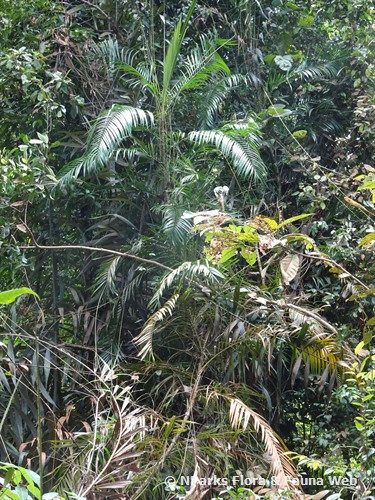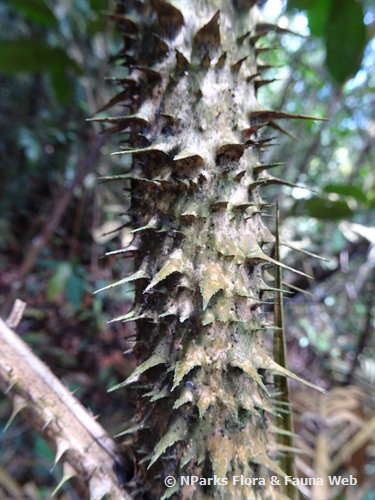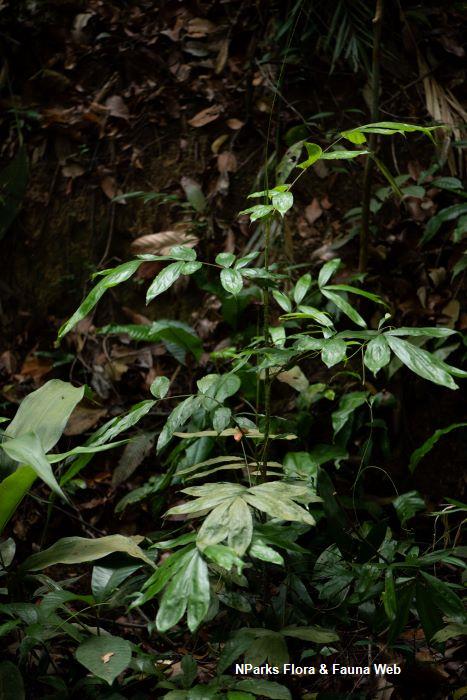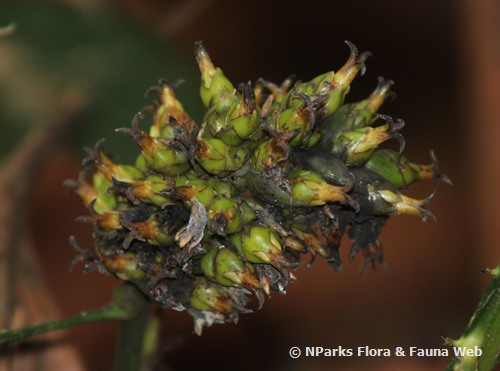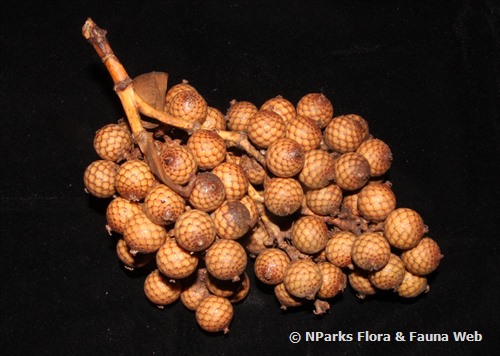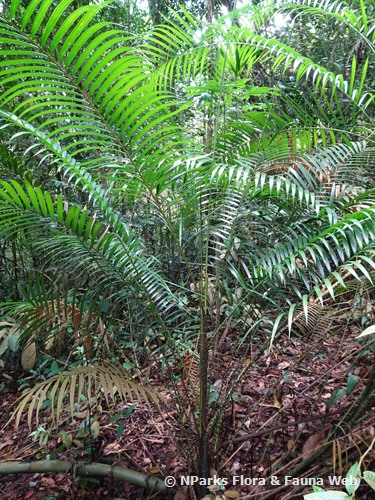
Back
Calamus densiflorus Becc.
| Family Name: | Arecaceae (Palmae) |
| Synonyms: | Calamus neglectus Becc. |
Calamus densiflorus is a clustering rattan palm with a climbing habit, able to reach a height of 40 m. The species was previously presumed Nationally Extinct in Singapore until its rediscovery in 2016, and was subsequently reassigned to Critically Endangered.
Name
Classifications and Characteristics
| Plant Division | Angiosperms (Flowering Seed Plants) (Monocotyledon) |
|---|---|
| Plant Growth Form | Palm (Clustered Habit), Climber |
| Mode of Nutrition | Autotrophic |
Biogeography
| Native Distribution | Singapore, Peninsular Malaysia, Thailand. |
|---|---|
| Native Habitat | Terrestrial (Riverine, Primary Rainforest) |
| Preferred Climate Zone | Tropical |
| Local Conservation Status | Native to Singapore (Critically Endangered (CR)) |
Description and Ethnobotany
| Growth Form | It is a clustering palm, reaching up to 40 m in height. |
|---|---|
| Foliage | The fronds are arching, about 1 m long, and even-pinnately compound with regularly arranged leaflets that are bristly on both margins. The fronds lack a cirrus (an extended portion of the leaf rachis/midrib that aids in climbing in rattan). The leaf sheaths are densely covered in hairy, slightly reflexed, blackish-brown prickles with swollen bases. The petioles (leaf stalks) in juvenile specimens can reach up to 20 cm long, while they are absent in mature specimens. |
| Stems | The flexible stems are covered in bright yellowish-green leaf sheaths up to 4 m in width. The stems are densely covered in hairy, slightly reflexed, blackish-brown prickles with swollen bases. |
| Flowers | The male inflorescence has slightly recurved rachillae (minor, secondary axes on inflorescences) and is branched to 3 orders. The female inflorescence exhibits second-order branching, with rachillae that are slightly recurved and measure up to 10 cm in length. The bracts are sparsely prickly. The flagellum (a spiny, whip-like, sterile modified inflorescence axis that aids in climbing in rattans) can reach up to 3 m long. |
| Fruit | The fruit is scaly and ovoid, about 2 cm long and 1.2 cm wide. |
| Habitat | It can be found in lowland to hilly tropical rainforests, up to 600 m above sea level. It avoids swamp forests but can be found on river banks. |
| Similar | This species is very similar to another local species, Calamus ridleyanus and can be accurately differentiated by the subcirrate leaves, spicy rachillae bracts and reflexed recurving rachillae of Calamus ridleyanus. |
| Taxonomy | The species was previously presumed Nationally Extinct in Singapore until its rediscovery in 2016, and was subsequently reassigned to Critically Endangered. |
| Etymology | The genus Calamus is derived from Greek kálamos, "reed/stalk", referring to the habit of the palm. |
Landscaping Features
| Landscape Uses | Riverine |
|---|---|
| Thematic Landscaping | Naturalistic Garden |
| Usage Hazard - Cons | Spines/Thorns - Leaf, Spines/Thorns - Flower, Spines/Thorns - Stem/Branch |
| Usage Hazard - Cons Remarks | Spine Thorns Leaf/Flower/Stem/Branch: The plant is covered in sharp spines and bristles and may not be suitable for landscaping in high human traffic. |
Plant Care and Propagation
| Light Preference | Semi-Shade |
|---|---|
| Water Preference | Moderate Water |
| Plant Growth Rate | Moderate |
| Rootzone Tolerance | Fertile Loamy Soils, Well-Drained Soils |
| Propagation Method | Seed |
Foliar
| Foliage Retention | Evergreen |
|---|---|
| Mature Foliage Colour(s) | Green, Green - Light Green |
| Mature Foliage Texture(s) | Spiny / Bristly / Stinging |
| Foliar Modification | Prickle / Emergence (blade) |
| Foliar Type | Compound (Even-Pinnate) |
| Foliar Arrangement Along Stem | Spiral |
| Foliar Attachment to Stem | Petiolate |
| Foliar Shape(s) | Palm Fronds (Pinnate / Feather) |
| Foliar Margin | Ciliate / Hairy |
Non - Foliar and Storage
| Trunk Type (Palm) | Clustering Habit |
|---|---|
| Stem Type & Modification | Thorn / Prickle |
| Root Type | Underground (Fibrous Root) |
Floral (Angiosperm)
| Flower & Plant Sexuality | Unisexual Flowers , Dioecious |
| Flower Texture(s) | Bristly |
|---|
| Flower Grouping | Cluster / Inflorescence |
| Flower Location | Axillary |
| Inflorescence Type | Spikelet / Compound Spike |
| Ovary Position | Superior / Hypogynous |
| Flowering Habit | Polycarpic |
Fruit, Seed and Spore
| Fruit Classification | Simple Fruit |
|---|---|
| Fruit Type | Fleshy Fruit , Drupe |
| Seed Quantity Per Fruit | Few (1-5) |
References
| References | Loo, A.H.B, Lua, H.K., Ang, W.F. (2017). Rediscovery in Singapore of Calamus densiflorus Becc. (Arecaceae). NATURE IN SINGAPORE (10). pp 1–5 |
|---|
Image Repository
Others
| Master ID | 30957 |
|---|---|
| Species ID | 5343 |
| Flora Disclaimer | The information in this website has been compiled from reliable sources, such as reference works on medicinal plants. It is not a substitute for medical advice or treatment and NParks does not purport to provide any medical advice. Readers should always consult his/her physician before using or consuming a plant for medicinal purposes. |


